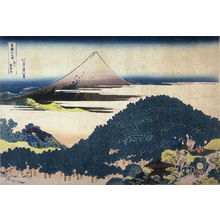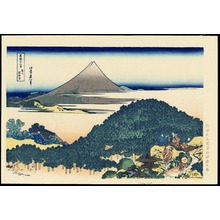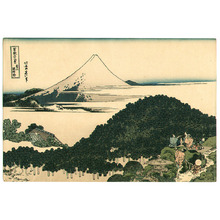葛飾北斎による浮世絵「The Cushion-Pine at Aoyama, Edo」
作者:葛飾北斎
作品名:The Cushion-Pine at Aoyama, Edo
制作年:c. 1830 - 1834
詳細:詳細情報...
情報源:ホノルル美術館
浮世絵(全 5,476 件)を表示...
説明:
Hokusai depicts Fuji from the garden of Ryüganji, a Zen temple also famous for its fantastic pine tree. With its enormously outspread branches, the canopy of this tree looks like a gigantic green cushion; thus it was called the Cushion-pine. Some branches were over 42 feet long and could not bear their own weight, so they were supported by stilts. Each branch and its pine needles are executed in minute detail. In front of the pine are picnickers. A father and son walking hand-in-hand climb the hill to where two men are already seated on a rug, enjoying themselves and drinking sake. Ryüanji was located in present-day Harajuku 1-chome, Shibuya ward, a posh center for young people. The Cushion-pine was mentioned in an Edo guidebook. Töto Ichiran Musashikö (Kondö 1966, no. 8). Hokusai's chief intent here is to depict this spectacular tree. By combining Fuji and the Cushion-pine, he appealed to people's interests. He carried this intent throughout the series. The secret of Hokusai's success in the Mount Fuji series is that he combined the beloved mountain with scenes of famous sites people had heard about and wanted to see. The enormous pine could have posed a direct competition to the mountain if seen against Fuji. Hokusai solved this problem by placing the tree off-center in the lower right, so that Fuji's long left flank runs parallel to the long cascading branches. The key-block was printed in blue. (The Asian Art Museum of San Francisco, HOKUSAI AND HIROSHIGE – Great Japanese Prints from the James A. Michener Collection, Honolulu Academy of Arts: The Asian Art Museum of San Francisco, 1998 Page 60. Cat. 11) - - - - - - - - - - - -
類似の浮世絵




















![Aoyama Enza-no-matsu 青山圓座枩 (Cushion Pine at Aoyama [Edo]) / Fugaku sanju-rokkei 冨嶽三十六景 (Thirty-Six Views of Mt Fuji) Katsushika Hokusai, 葛飾北斎 (Katsushika Hokusai (葛飾北斎))による浮世絵「Aoyama Enza-no-matsu 青山圓座枩 (Cushion Pine at Aoyama [Edo]) / Fugaku sanju-rokkei 冨嶽三十六景 (Thirty-Six Views of Mt Fuji)」](https://data.ukiyo-e.org/bm/thumbs/AN00144038_001_l.jpg)



